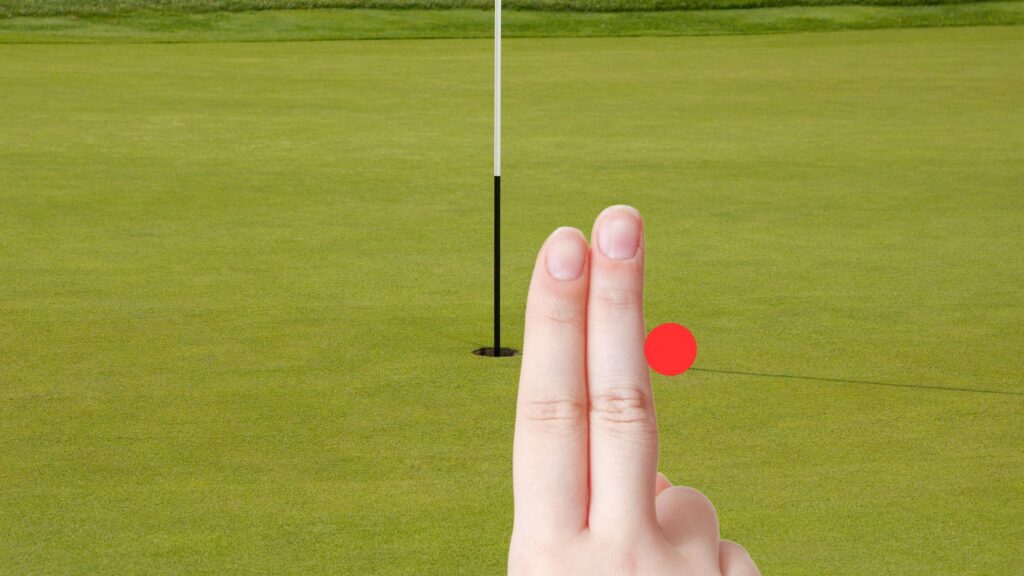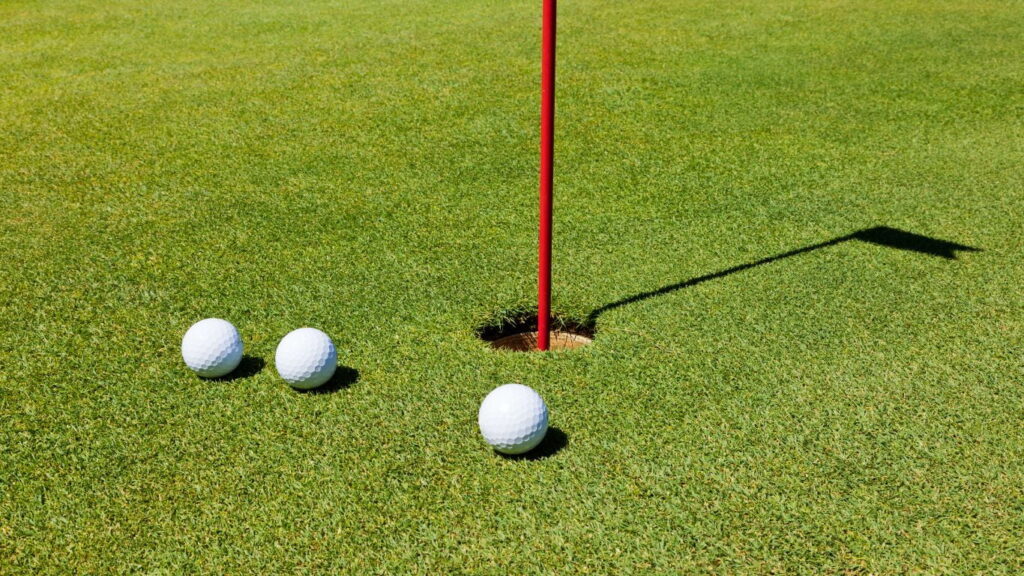If you’re a golfer, you know that one of the most important aspects of the golf game is reading the green. Putting is a delicate art, and understanding how the ball will roll on the green is crucial to making accurate shots. That’s where AimPoint Express comes in.
AimPoint Express is an effective green reading system, that takes the guesswork out of green reading. It’s a system that’s been used by professional golfers for years, but it’s also accessible to amateur players.
The method involves using your feet to feel the slope of the green and determine the direction and amount of break.

What is the AimPoint putting system?
The AimPoint Express system was developed by Mark Sweeney, a former software engineer turned golf instructor. He realized that the traditional method of reading greens, which involves looking at the slope and using your instincts to determine the break, was often inaccurate. He began studying the basic physics of putting and realized that there was a better way.
The AimPoint Express system involves using a chart that corresponds to the slope of the green. Golfers use their feet to feel the slope and then consult the chart to determine the exact direction and amount of break. The AimPoint system takes into account variables like speed, slope, and grain, and is designed to be accurate no matter where you are on the green.
One of the benefits of the AimPoint Express system is that it’s easy to learn. Golfers can take a clinic or watch a video to understand the basics of the method, and then practice on their own. The AimPoint golf system can be used with any putter, and there’s no need for special equipment or gadgets.
In addition to its accuracy and ease of use playing something most golfers do with, the AimPoint Express system is also a time-saver. By eliminating the guesswork, golfers can make their putts more quickly and confidently, without having to spend time analyzing the green.
Getting started with the AimPoint putting green reading system

If you’re interested in trying the AimPoint Express putting method, there are a few ways to get started. One option is to visit the official AimPoint putting, website, where you can find information on clinics, instructors, and training aids.
You can also purchase the AimPoint Express green-reading book or download the AimPoint Express app, which provides access to the same charts and information used by professional golfers.
Another option is to watch a tutorial video credited to AimPoint, such as the one on YouTube titled “AimPoint Green Reading Explained“. This video provides a clear and concise overview of the three-step aim point using process, as well as tips and tricks for using the method effectively.
Watch the video: “AimPoint Putting Green Reading Explained“
Once you’ve familiarized yourself with the basics of the AimPoint Express method, it’s important to practice regularly to build your skills and confidence.
Start by using the method on the putting green during practice rounds or casual games. Pay attention to how the ball reacts to the slope of the green and make adjustments as necessary.
You may also want to consider taking a clinic or working with a certified AimPoint instructor to receive personalized instruction and feedback. With time and practice, you’ll be able to correctly read greens and with greater accuracy and make more confident putts using the AimPoint Express method.
Step One: Feel the slope

Feeling the slope of the green involves using your feet to sense the changes in elevation and contour on the putting surface. This is a critical first step because it provides the foundation for the rest of the AimPoint Express system.
By understanding the slope of the green, you’ll be able to determine the direction and amount of break, which will help you make more accurate putts.
To feel the slope of the green, begin by standing behind your ball and looking at the putting surface. Take note of any noticeable changes in elevation or contour. Then, take a few steps towards the hole and continue to observe the green.
You may notice that the green slopes from right to left or left to right, or that it has a subtle rise or fall. These are the types of details that you’ll need to sense with your feet in order to make an accurate putt.
Once you’re standing near the ball, take a few practice strokes and pay attention to the sensations in your feet. You should be able to feel the changes in slope as you move your weight from one foot to the other.
This can take some practice to master, but with time you’ll become more attuned to the subtle changes in elevation on the green. As you’re feeling the slope of the green, it’s important to pay attention to the entire putting surface, not just the area immediately around the ball. This will help you get a more complete picture of the contours of the green and make a more accurate assessment of the direction and amount of break.
Step Two: Aim Your Putt

Once you’ve felt the slope of the green using your feet, it’s time to aim your putt. The goal of this step is to align your putter face with the slope of the green so that the ball will travel in the desired direction and break towards the hole.
To aim your putt, begin by standing behind your ball and looking at the line from the ball to the hole. This is the line that the ball will travel along as it rolls towards the hole.
You’ll want to choose a spot for longer putts are on the outside finger this line where you want the ball to start breaking towards the hole.
Next, position yourself behind the ball and use your feet to feel the slope of the green. This will give you an idea of how much break you’ll need to play to get the ball to the starting spot you’ve chosen.
Now, it’s time to aim your putter. Start by positioning your feet parallel to the line of the putt. Then, point the face of your putter directly at the starting spot on the practice green you’ve chosen. The putter face should be perpendicular to the slope of the green at this aiming point.
Once you’ve aimed your putter, take your stance and make any necessary adjustments to your alignment. You may need to move your feet slightly to ensure that the proper line of your body is aligned with the correct line between the intended line of the putter face and the line of the putt.
Finally, make your stroke, keeping your eyes focused on the starting spot for more putts and the hole. If you’ve aimed your putter correctly, the ball should start rolling towards the starting spot you’ve chosen and then break towards the hole.
Step Three: Make Everything

Making everything in the AimPoint Express method means taking into account all of the variables that can affect your putt and making adjustments as necessary. This includes factors like speed, grain, and slope, as well as your own stroke mechanics and mental focus.
To make everything, start playing golf first by taking a few practice strokes and getting a feel for the speed of the green. This will help you determine how much force to the correct speed and use when striking the ball.
Next, consider the grain of the green. Grain refers to the direction in which the grass blades are growing. This can affect the way the golf ball itself rolls on the green, so it’s important to take it into account when making your putt.
If the grain is growing towards the hole, the ball will tend to break less. If the grain is growing away from the hole, the ball will tend to break more.
Once you’ve considered the speed and grain of the green, it’s time to focus on the slope. Remember the information you gathered in the first step by feeling the slope of the green. This will help you determine the direction and amount of break you’ll need to play in order to get the ball in the hole.
Finally, it’s important to focus on your own stroke mechanics and mental focus. Make sure you’re standing in a comfortable position and that your grip on the putter is secure. Take a deep breath and visualize the ball rolling into the hole.
Then, make your stroke with confidence and follow through with a smooth motion.
In conclusion, making everything is a critical third step in putting success with the AimPoint Express putting method. By taking into account all of the variables that can affect your putt and making adjustments as necessary, you’ll be able to make more accurate putts with greater confidence.
With practice, these three learn AimPoint express putting technique can help you become a more effective and consistent putter on the green.
AimPoint FAQs

What is AimPoint in putting?
AimPoint in putting is a putting method that uses science and technology to read the slope and break of a green. It is based on the idea that putts are affected by gravity and that the slope of a green can be determined by using the feet as a tool to measure the slope.
Is AimPoint putting legal?
Yes, AimPoint putting is legal in professional and amateur golf tournaments. The United States Golf Association (USGA) and the Royal and Ancient Golf Club of St. Andrews (R&A) have both approved the use of AimPoint technology and its methods in competitions.
Who uses AimPoint putting?
AimPoint putting is used by professional golfers on the PGA Tour, LPGA Tour, European Tour, and other professional golf tours around the world. It is also used by amateur golfers of all levels who are looking to improve their putting skills.
What is the AimPoint putting method?
The AimPoint putting method involves the use of fingers to measure the slope of the green and determine the break of a putt. Golfers use their fingers to feel the slope and then align their feet and body to the slope to make a more accurate putt.
How does AimPoint Express work?
AimPoint Express is a simplified version of the AimPoint putting method that uses a numbering system to help golfers determine the slope and break of a putt.
It involves standing behind the ball and holding up fingers to determine the slope, then using a chart to convert the slope into a number that indicates the amount of break.

What are the best golf ball putting methods?
The best putting methods vary from golfer to golfer, as each individual has their own preferences and techniques. Some popular putting methods include the pendulum stroke, the claw grip, the reverse overlap grip, and the conventional grip.
How do you line up a putt with your fingers on the putting green?
Lining up a putt with your fingers involves using your index and middle fingers to feel the slope of the green. Golfers align their fingers with the line of the putt and then use that information to adjust their aim and make a more accurate putt.
Why do PGA players straddle the putting line?
PGA players straddle the putting line to get a better view of the line and slope of the putt. By standing directly over the ball, they can see the break more clearly and make more accurate reads.
What pro golfers use AimPoint Putting?
Several PGA Tour players use AimPoint putting, including Adam Scott, Stacy Lewis, Lydia Ko, and Justin Rose, among others.
Does AimPoint use percent or degrees?
AimPoint uses both degrees and percentages to measure the slope and break of a putt. The degree system is used to measure the slope of the green, while the percentage system is used to indicate the amount of break.
Why do golfers hold up their fingers when putting?
Golfers hold up their fingers when putting to measure the slope of the green and determine the break of the putt. By using their fingers to feel the slope, golfers can make more accurate putts.
Who developed AimPoint putting?
AimPoint putting was developed by Mark Sweeney, a former software engineer who used his skills in physics and math to create a putting method based on scientific principles.
Sweeney launched AimPoint in 2005 and has since trained thousands of golfers around the world in the method.
How to Practice Feeling The Slope With Your Feet?
The first step in practicing feeling the slope with your feet is to pay close attention to the way the ground feels under your feet as you walk on the green. You should be able to feel subtle changes in elevation and slope, which can give you important information about the contour of the green.
Another helpful tip is to practice taking practice swings with your feet in different positions. Try standing with your feet parallel to the slope, with your toes pointing uphill, and with your toes pointing downhill. Take a few practice swings in each position and pay close attention to how it feels to swing on the slope. This can help you get a better sense of the slope’s direction and how it will affect your shots.
When you’re on the course, take the time to walk around the green and get a feel for the slope before making your shot. Stand on different parts of the green and pay attention to how it feels under your feet. This can help you make more accurate judgments about the direction and severity of the slope.
Finally, consider practicing with a training aid designed to help golfers improve their ability to feel the slope with their feet. There are a variety of training aids available, including mats with built-in slopes and devices that attach to your shoes to provide tactile feedback as you walk on the green.
By practicing feeling the slope with your feet, you can gain a better understanding of the contour of the green and make more accurate shots on the course. With a little bit of patience and persistence, you can improve your overall golf game and enjoy more success on the green.







